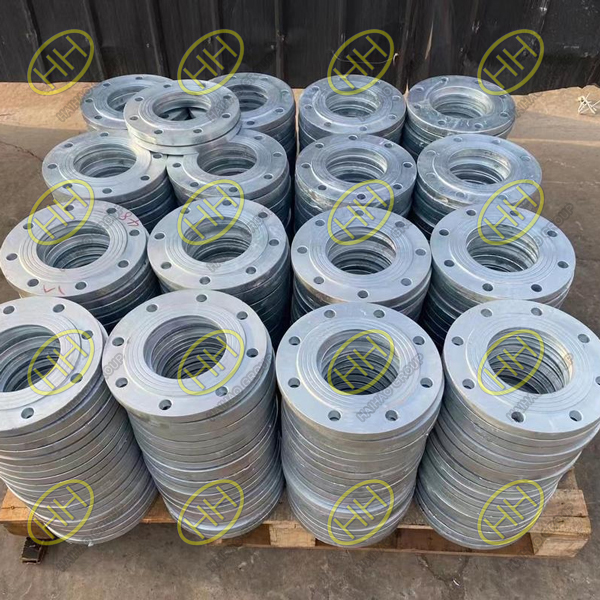Hot dip galvanizing process and benefits of flange
Hot-dip galvanizing is a widely used method to enhance the corrosion resistance of steel components, including flanges. This process involves coating steel with a layer of zinc, which acts as a protective barrier against environmental elements, thereby significantly extending the product’s life.
Hot-dip galvanizing is a process where steel components are submerged in a bath of molten zinc at a temperature of around 450°C (842°F). The zinc reacts with the steel to form a series of zinc-iron alloy layers and a final layer of pure zinc on the surface. This provides a durable and long-lasting protective coating that helps steel resist rust and corrosion.
The hot-dip galvanizing process for flanges
1.Surface Preparation: Before galvanizing, the flange undergoes a cleaning process. This includes degreasing to remove any oil or dirt, pickling in an acid solution to eliminate mill scale and rust, and rinsing. These steps ensure that the surface of the flange is clean and ready for zinc bonding.
2.Fluxing: The cleaned flange is then dipped into a flux solution (typically zinc ammonium chloride). This step helps remove any remaining oxides and prevents oxidation before the flange enters the zinc bath.
3.Galvanizing: The flange is submerged in a molten zinc bath heated to around 450°C. The zinc reacts with the steel surface, forming a metallurgically bonded coating of zinc-iron alloy. The flange remains in the zinc bath until the reaction is complete and the desired coating thickness is achieved.
4.Cooling: After galvanizing, the flange is removed from the zinc bath and cooled, either by air or water quenching. This step solidifies the zinc coating, ensuring it adheres firmly to the steel surface.
5.Inspection: The final step involves inspecting the galvanized flange to ensure that the zinc coating is even and free from any defects. Measurements may also be taken to verify that the coating thickness meets the required specifications.
Benefits of hot-dip galvanizing for flanges
1.Corrosion Resistance: The zinc coating protects the steel flange from corrosion by acting as a barrier against moisture and oxygen. Even if the surface is scratched, the zinc continues to protect the steel through a process called galvanic action.
2.Complete Coverage: The hot-dip galvanizing process ensures that even hard-to-reach areas, such as inside edges and threads, are thoroughly coated. This uniform coverage provides comprehensive protection, which is particularly important for flanges exposed to harsh conditions.
3.Eco-Friendly: Zinc is a recyclable material, and the galvanizing process is energy-efficient. Moreover, the extended lifespan of galvanized flanges reduces the need for frequent replacements, contributing to resource conservation.
In conclusion, hot-dip galvanizing is an effective method for enhancing the performance and longevity of flanges. By choosing this process, manufacturers ensure that their products can withstand the challenges posed by various industrial and environmental conditions.


